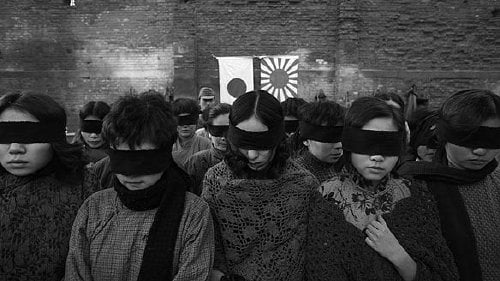City of Life and Death

Shortly after the beginning of the Second-Sino-Japanese War in 1937, Japanese troops captured the capital of the Chinese republic – Nanking. The atrocities that fell upon the survivors came to be known as the Rape of Nanking and writer-director Lu Chuan tells the story of the “City of Life and Death.”
Laura's Review: A
In 1937, after Shanghai had fallen, the Japanese Army quickly took the Republic of China's capital Nanjing. In this period of history, most commonly referred to as the 'Rape of Nanking,' 300,000 soldiers and civilians lost their lives. Countless others were raped and wounded in a "City of Life and Death." Diaries and survivors' accounts provided writer/director Lu Chuan ("The Missing Gun") with a different perspective than the traditional Chinese one, that the Japanese are somehow different, their makeup more brutal. His portrayal of Japanese soldier Kadokawa (Hideo Nakaizumi) as a man horrified by what is being done to the Chinese and haunted by a beautiful young comfort woman, Yuriko (Yuko Miyamoto), actually brought Chuan death threats. But it is this humanity, standing beside horrific crimes against same, which makes "City of Life and Death" one of the greatest war films. Nothing is black and white. There are Chinese heroes, martyrs and decent family men who betray their own to save family. There are outsiders, like the famous Nazi John Rabe (John Paisley), who work within the Safety Zone to save as many as they can (his story was most recently told in the 2007 documentary "Nanking"). The 'Rape of Nanking' is dramatized by Chuan from three points of view. We meet a handsome Chinese soldier, Lu Jianxiong (Ye Liu, "Curse of the Golden Flower"), trying to hold the North Gate along with his companion Shunzi (Yisui Zhao) and the twelve year old Xiaodouzi (Bin Liu), but it is an impossible feat. On the other side is Kadokawa, under the command of Ida (Ryu Kohata), a steely man seemingly not only devoid of compassion but leaning heavily towards a streamlined barbarity. The third is Mr. Tang (Fan Wei), the Chinese assistant of Rabe whose influence he expects will save himself along with his wife (Lan Qin), daughter and sister-in-law Mai. The Safety Zone has several other notable characters at work, including Miss Jiang (Yuanyuan Gao, "Beijing Bicycle"), in charge of the women's part of the camp, American Minnie Vautrin (Beverly Peckous) and Xiaojiang (Jiang Yiyan), a prostitute who refuses to make herself look like a boy to protect herself from Japanese soldiers and who later makes a bold stance when Ida demands 100 'volunteers' to serve as comfort women to his men. Chuan makes the horrors of war evident without being overly graphic. We see innocents locked inside a burning church, others mowed down and buried, along with the still living, in mass graves. The pregnant women and young mothers who witnessed their children being held aloft on bayonets are represented by the fate of one child which, although bloodless for the audience, is shocking nonetheless. Working in black and white, director of photography Cao Yu achieves a stark beauty even portraying unimaginable events. Chuan even ends his film on a note of cautioned hope without sentimentality, always maintaining his balance between the good and evil impulses of men. "City of Life and Death" was inexplicably not chosen for competition in Cannes last year, but went on to win the Golden Shell in San Sebastian, Europe's third largest festival. Kudos to distributor Kino Lorber for bringing this masterpiece, one of the greatest war films ever made. to U.S. theaters.
Robin's Review: B+
“First we eat, then we do everything else” M.F.K. Fisher (The Art of Eating). Thus begins Jonathan Gold’s journey of discovery of the myriad of restaurants in a place very different from the rest of the country, food-wise. Gold explains that the city of LA, unlike other American cities, is not a melting pot of cultures but a glittering mosaic in its sprawl of ethnic foods. He also sets himself and other real food critics apart from those who vent their spleen on YELP. For instance, Gold will visit his subject restaurants four or five times before writing his review. Gabbot’s camera follows the corpulent foodie to all of his favorite haunts, from Downtown to Koreatown to the predominantly Chinese Alhambra District and Beverly Hills. He talks about the projects that he took on in his love of food, including a year-long journey called the Pico Boulevard Project. That project had Gold sampling the victuals of every restaurant along the 15 mile road. “City of Gold” is a love poem to the Los Angeles food scene and to the man who made it his mission…to eat.

